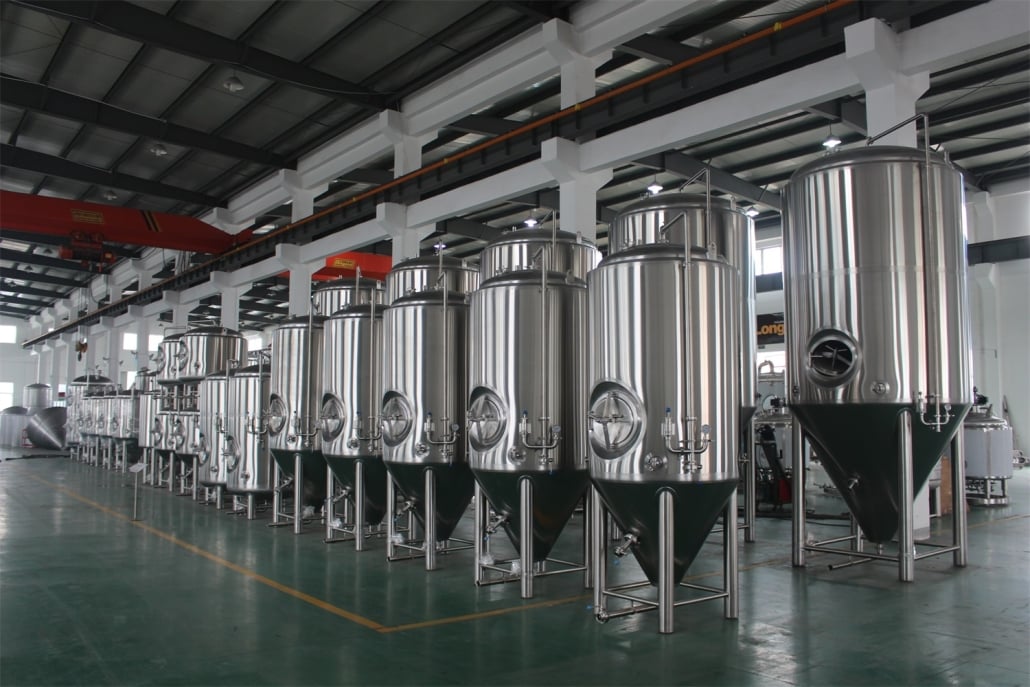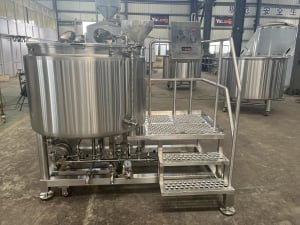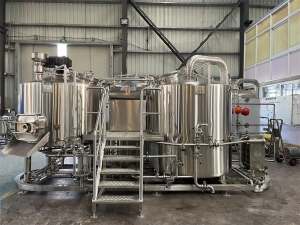Table of Contents
ToggleIntroduction
In the world of brewing, efficiency and consistency are paramount. Brewers constantly seek innovative ways to streamline their operations and produce high-quality beer. One such solution that has gained popularity in recent years is the 10 bbl unitank. This article delves into the various aspects of a 10 bbl unitank, including its definition, working principles, benefits, installation, maintenance, and much more.
What is a 10 bbl Unitank?
A 10 bbl unitank, also known as a 10-barrel unitank, is a cylindrical vessel used in the brewing industry for fermenting and conditioning beer. It is specifically designed to handle a batch size of 10 barrels, making it ideal for microbreweries and craft breweries looking to scale up their production. The unitank combines the functions of both a fermentation vessel and a bright tank, eliminating the need for multiple containers and simplifying the brewing process.
Components of a 10 bbl Unitank
A 10 bbl unitank consists of several essential components that work together to ensure optimal beer fermentation and conditioning. These components include:
- Cylindrical Body: The main vessel of the unitank, usually made of stainless steel, provides a sealed environment for the fermentation process.
- Dome Top: The dome-shaped top of the unitank allows for the accumulation of carbon dioxide produced during fermentation and provides a space for pressure relief.
- Cone Bottom: The conical shape of the bottom facilitates the settling of yeast and other solids, making it easier to separate the clarified beer during the conditioning phase.
- Pressure Relief Valve: This safety feature ensures that excessive pressure inside the unitank is released, preventing any potential damage to the vessel.
- Sampling Valve: Used for taking samples of the beer during fermentation and for monitoring specific gravity and other parameters.
- Temperature Control System: A 10 bbl unitank is equipped with a temperature control system to maintain precise fermentation temperatures, crucial for consistent beer quality.
- Carbonation Stone: This component is responsible for injecting carbon dioxide into the beer during the carbonation process, ensuring the desired level of carbonation.
Benefits of Using a 10 bbl Unitank
The utilization of a 10 bbl unitank in brewery operations offers numerous benefits:
- Space Efficiency: A single 10 bbl unitank replaces the need for separate fermentation vessels and bright tanks, saving valuable floor space in the brewery.
- Streamlined Workflow: The integration of fermentation and conditioning in one vessel simplifies the brewing process, reducing the time and effort required to transfer beer between multiple containers.
- Improved Quality Control: The ability to control fermentation temperature, pressure, and carbonation levels results in consistent beer production and allows brewers to achieve their desired flavor profiles.
- Reduced Risk of Contamination: Minimizing the exposure of beer to oxygen and other contaminants during transfers reduces the risk of off-flavors and infection, leading to higher-quality products.
- Scalability: A 10 bbl unitank is an excellent choice for breweries looking to expand their production capacity while maintaining efficiency and flexibility.
- Cost Savings: By eliminating the need for additional tanks, a 10 bbl unitank reduces capital expenditures and lowers operational costs associated with maintenance and cleaning.
- Increased Productivity: With faster fermentation and conditioning cycles, breweries can produce more batches in a shorter time, leading to increased overall productivity.
How Does a 10 bbl Unitank Work?
A 10 bbl unitank operates through a well-defined fermentation and conditioning process:
- Fermentation: After the brewing process is complete, the beer is transferred to the unitank for fermentation. Yeast is added, and the vessel is sealed to create an anaerobic environment. The yeast consumes sugars, converting them into alcohol and carbon dioxide, resulting in the primary fermentation process.
- Conditioning: Once the primary fermentation is complete, the beer undergoes conditioning, where it is further clarified, and flavors develop. The conical bottom of the unitank aids in the settling of solids, allowing for the removal of clear beer from the top.
- Carbonation: In the final stage, carbonation is introduced to the beer. A carbonation stone is used to infuse carbon dioxide, achieving the desired level of carbonation. After this step, the beer is ready for packaging or kegging.
Factors to Consider When Choosing a 10 bbl Unitank
When selecting a 10 bbl unitank for your brewery, several factors should be taken into account:
- Brewery Size and Production Goals: Consider the size of your brewery and the projected production volume to determine if a 10 bbl unitank is the appropriate choice for your needs.
- Space Availability: Evaluate the available space in your brewery and ensure that the unitank’s dimensions and installation requirements align with your layout.
- Quality and Material: Choose a unitank made from high-quality stainless steel to ensure durability, resistance to corrosion, and ease of cleaning.
- Temperature Control Features: Look for a unitank that offers precise temperature control options to maintain optimal fermentation conditions.
- Pressure Rating: Consider the pressure rating of the unitank to accommodate your specific brewing requirements and future expansion plans.
- Additional Features: Some unitanks may offer advanced features such as automated control systems, data logging capabilities, or glycol jacketing for enhanced temperature control.
- Price and Warranty: Compare prices and warranties offered by different manufacturers to make an informed decision based on your budget and long-term support needs.
Installation and Setup of a 10 bbl Unitank
Installing and setting up a 10 bbl unitank requires careful planning and adherence to certain steps:
- Designated Space: Identify a suitable location in your brewery where the unitank will be installed. Ensure there is enough space for the unitank, as well as clearance for maintenance and access to valves and controls.
- Utilities: Make sure all necessary utilities are available at the installation site. This includes connections for water supply, drainage, and electrical power.
- Flooring and Support: Ensure that the floor can support the weight of the unitank when fully loaded. Consult a structural engineer if needed. Additionally, consider using a non-slip and easy-to-clean flooring material in the immediate area surrounding the unitank.
- Piping and Connections: Install appropriate piping for beer transfer, temperature control, and carbonation. Ensure that the connections are properly sealed to prevent any leaks.
- Electrical Wiring: Connect the electrical wiring according to the manufacturer’s instructions. This may include wiring for temperature control, pressure sensors, and control panels.
- Glycol System: If your unitank includes a glycol jacket for precise temperature control, set up the glycol system with the necessary pumps, piping, and a chiller or glycol reservoir.
- Calibration and Testing: Before using the unitank, calibrate any sensors or probes and conduct a thorough leak test. Check the functionality of valves, pressure relief systems, and temperature control systems.
- Safety Considerations: Ensure that the unitank is properly secured to prevent tipping or movement. Install safety features such as pressure relief valves and emergency shut-off switches in case of any issues.
- Training and Familiarization: Train brewery staff on the operation, cleaning, and maintenance procedures specific to the unitank. Familiarize them with safety protocols and emergency procedures.
- Documentation and Compliance: Keep a record of the installation process, including any modifications or adjustments made. Ensure compliance with local regulations and safety standards.
By following these installation steps, you can successfully set up a 10 bbl unitank in your brewery, allowing for efficient and controlled fermentation and conditioning of your beer.
Maintenance and Cleaning of a 10 bbl Unitank
Proper maintenance and regular cleaning of a 10 bbl unitank are crucial for ensuring its longevity and the quality of your beer. Here are some important maintenance and cleaning guidelines:
- Routine Inspections: Regularly inspect the unitank for any signs of wear, leaks, or damage. Check the valves, gaskets, and seals for proper functioning and replace any worn-out components.
- Cleaning Procedures: After each batch, clean the unitank thoroughly to remove any residual yeast, sediment, or other contaminants. Follow the manufacturer’s cleaning instructions and use appropriate cleaning agents or sanitizers.
- Disassembly and Reassembly: If required, disassemble any removable components, such as sampling valves or carbonation stones, for a more thorough cleaning. Ensure proper reassembly and tight connections after cleaning.
- Pressure Testing: Periodically conduct pressure tests to ensure the integrity of the unitank. This helps identify any potential leaks or weak points that may require repairs.
- Temperature Control System Maintenance: If your unitank has a temperature control system, inspect and maintain the associated components regularly. Check the functionality of temperature sensors, controllers, and glycol circulation systems.
- Record Keeping: Maintain a log of maintenance activities, including cleaning schedules, repairs, and any modifications made to the unitank. This helps track maintenance history and ensures accountability.
- Professional Servicing: Consider engaging a professional brewery equipment service provider for periodic inspections and servicing. They can offer expertise in maintaining and troubleshooting unitanks.
By following these maintenance and cleaning practices, you can maximize the lifespan of your 10 bbl unitank and maintain the highest standards of cleanliness and hygiene.
Common Issues and Troubleshooting
Despite proper maintenance, unitanks may encounter occasional issues. Here are some common problems that brewers may face and suggested troubleshooting steps:
- Leaking Valves or Fittings: Inspect the affected valves or fittings for loose connections or damaged gaskets. Tighten the connections or replace the gaskets as needed.
- Pressure Build-up or Release Issues: Check the pressure relief valve for any blockages or malfunctions. Clean or replace the valve if necessary.
- Temperature Control Problems: Ensure that the temperature control system is properly calibrated and functioning. Verify the accuracy of temperature sensors and recalibrate if required. Check the glycol system for leaks or insufficient cooling capacity.
- Excessive Sediment or Yeast Build-up: Increase the frequency of cleaning or consider adding a filtering step to your process. Adjust the fermentation parameters to reduce the amount of sediment or yeast carried over during transfer.
- Off-flavors or Contamination: Review your cleaning and sanitation procedures to ensure they are thorough and effective. Implement additional cleaning steps or sanitization methods if necessary.
If troubleshooting steps do not resolve the issue, consult the manufacturer’s support or seek assistance from a professional brewery equipment service provider.
Comparison between 10 bbl Unitanks and Other Brewing Equipment
To understand the unique advantages of a 10 bbl unitank, it’s essential to compare it to other brewing equipment commonly used in the industry. Here’s a comparison between 10bbl unitanks and alternative options:
- 10bbl Unitanks vs. Conventional Fermenters and Bright Tanks: Compared to separate fermenters and bright tanks, 10bbl unitanks offer space efficiency, streamlined workflow, and improved quality control. They eliminate the need for beer transfers between vessels, reducing the risk of contamination and saving time.
- 10bbl Unitanks vs. Multiple Smaller Fermenters: When compared to using multiple smaller fermenters, a 10bbl unitank reduces the footprint required for equipment. It simplifies the brewing process by consolidating fermentation and conditioning in a single vessel, resulting in cost savings and improved productivity.
- 10bbl Unitanks vs. Open-Top Fermenters: Open-top fermenters are popular for certain beer styles, such as traditional Belgian ales. However, 10bbl unitanks offer better control over fermentation parameters, reduced risk of contamination, and enhanced carbonation capabilities.
- 10bbl Unitanks vs. Unitanks of Different Capacities: Unitanks are available in various sizes, including 10bbl, 20bbl, and beyond. The choice depends on the specific production volume and space constraints of the brewery. However, a 10bbl unitank strikes a balance between scalability and operational efficiency for many craft breweries.
When evaluating different brewing equipment options, consider your brewery’s needs, available space, production goals, and long-term scalability.
Cost of a 10bbl Unitank
The cost of a 10bbl unitank can vary depending on several factors, including the manufacturer, material quality, additional features, and regional market conditions. While prices can fluctuate, a ballpark estimate for a high-quality 10bbl unitank typically ranges from $10,000 to $20,000 USD.
It’s essential to consider the total cost of ownership when evaluating the investment. Factors such as maintenance costs, warranty coverage, and the reputation of the manufacturer should also be taken into account. Research different suppliers, request quotes, and compare the features and after-sales support provided before making a purchasing decision.
Keep in mind that the cost of a 10bbl unitank is not the only financial consideration. You should also factor in the potential cost savings and benefits it offers in terms of operational efficiency, increased productivity, improved beer quality, and reduced space requirements.
By investing in a 10bbl unitank, you can eliminate the need for separate fermentation vessels and bright tanks, resulting in cost savings on equipment purchases and installation. Additionally, the streamlined workflow and reduced transfer steps minimize the risk of beer contamination, saving money on wasted batches and maintaining consistent quality.
Furthermore, the space efficiency of a 10bbl unitank allows breweries to maximize their floor space utilization, potentially reducing facility costs or creating room for future expansion. The scalability of a unitank also provides flexibility to increase production capacity as demand grows, avoiding the need for additional equipment purchases.
When considering the cost of a 10bbl unitank, it’s essential to assess the long-term benefits and return on investment it can provide to your brewery.
Future Trends in 10bbl Unitank Technology
The brewing industry continues to evolve, and technology plays a crucial role in driving innovation. Here are some future trends in 10bbl unitank technology to watch out for:
- Smart and Automated Control Systems: Advancements in automation and data collection technologies will enable more sophisticated control systems for unitanks. These systems will offer real-time monitoring, remote access, and predictive analytics to optimize fermentation parameters and reduce manual intervention.
- Integration with Brewing Software: Unitanks will become increasingly compatible with brewing software, allowing seamless data exchange and process integration. This integration will enable brewers to automate recipe management, fermentation profiles, and data logging, enhancing efficiency and quality control.
- Energy Efficiency and Sustainability: Manufacturers will focus on developing unitanks with improved energy efficiency features, such as better insulation, optimized cooling systems, and energy recovery mechanisms. Sustainability will be a key consideration, with emphasis on reducing water and energy consumption.
- Advanced Cleaning and Sanitization Methods: Unitanks will incorporate advanced cleaning and sanitization technologies, such as automated Clean-In-Place (CIP) systems and targeted cleaning solutions. These innovations will minimize cleaning time and resources while ensuring thorough sanitation.
- Customization and Modular Design: Manufacturers will offer more customization options to cater to specific brewery requirements. Modular designs will allow breweries to expand or reconfigure their unitanks easily as their needs evolve, providing flexibility and cost-effective scalability.
As technology progresses, these trends will shape the future of 10bbl unitanks, offering breweries even greater efficiency, control, and sustainability.
Conclusion
In conclusion, a 10bbl unitank is a valuable asset for breweries seeking efficiency, consistency, and scalability. By integrating fermentation and conditioning processes into a single vessel, unitanks simplify operations, save space, and enhance the quality of beer production.
The benefits of using a 10bbl unitank include space efficiency, streamlined workflow, improved quality control, reduced risk of contamination, scalability, cost savings, and increased productivity. Careful consideration should be given to factors like brewery size, space availability, quality and material, temperature control features, pressure rating, additional features, price, and warranty when choosing a 10bbl unitank.
Proper installation, maintenance, and cleaning procedures are essential for maximizing the lifespan of the unitank and ensuring optimal performance. Monitoring and addressing common issues, as well as staying informed about industry trends, will further contribute to the success of your brewery.
Investing in a 10bbl unitank not only provides immediate benefits but also positions your brewery for growth and innovation in the ever-evolving brewing industry.
FAQs (Frequently Asked Questions)
1. Can I use a 10bbl unitank for both fermentation and storage?
Yes, a 10bbl unitank serves the dual purpose of fermentation and storage. It eliminates the need for separate fermentation vessels and bright tanks.
2. What type of beer can I produce with a 10bbl unitank?
A 10bbl unitank can be used to produce various types of beer, including ales, lagers, stouts, and IPAs. Its versatility allows for the fermentation and conditioning of different beer styles.
3. Is temperature control crucial for a 10bbl unitank?
Yes, temperature control is essential for maintaining optimal fermentation conditions and achieving desired beer flavors and characteristics. A 10bbl unitank typically includes a temperature control system for precise temperature management.
4. How often should I clean a 10bbl unitank?
Cleaning should be performed after each batch of beer. Thorough cleaning ensures the removal of yeast, sediment, and other contaminants, maintaining the hygiene and quality of subsequent batches.
5. Can a 10bbl unitank be upgraded or expanded in the future?
Yes, 10bbl unitanks are designed to be scalable and can be expanded or modified to accommodate future brewery growth. Modular designs and customization options allow for easy upgrades and reconfigurations.







